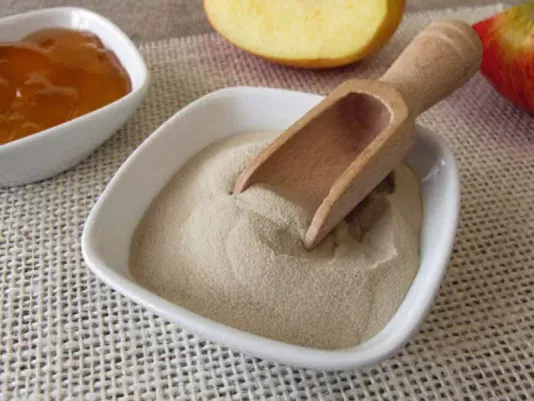Cake Pigeon's Milk
Cake Pigeon's Milk – a very popular cake in Soviet times was invented by a confectioner at the Prague restaurant.

Agar-agar was a true discovery for me when I began searching for a more natural and stable alternative to regular gelatin. As an experienced cook, I’ve made dozens of jellies, mousses, and fruit-based desserts, and with agar, I achieved results that had once seemed impossible. I’m drawn to its plant origin, neutral flavor, and ability to hold shape even in warm conditions. With it, I can create clean, elastic textures that don’t melt – perfect for layered desserts, decorations, or canapé-style appetizers. Additionally, agar-agar works wonderfully in savory dishes, from sauces to vegetable aspics. It sets quickly without needing to chill to 0 °C, which saves time in the kitchen. Agar-agar isn’t just a thickener – it’s a precision tool for confidently controlling a dish’s consistency.
Agar-agar is a natural gelling agent derived from red and brown seaweeds, particularly from the genera Gracilaria and Gelidium. It’s widely used in culinary arts, pharmaceuticals, cosmetics, and especially in dessert-making. Agar’s key feature is its ability to create a stable gel structure without any animal-derived components. I first tried using agar when making plant-based jelly, and after just a few trials, I was convinced of its reliability. Unlike gelatin, which needs low temperatures to set, agar starts to firm up at 35-40 °C and stabilizes completely at room temperature. This makes it incredibly convenient for preparing layered desserts, especially when time and precision matter. Agar doesn’t melt outside the fridge, yields a firmer and springier texture, and is ideal for decorating festive dishes or intricate plating.
Working with agar is simple if you follow a few key rules. I always start with precise measurements – unlike gelatin, agar is much stronger, and using too much can result in an overly firm, rubbery texture. For 500 ml of liquid, I usually use 4-6 grams of powder – enough to create a soft yet stable jelly. Agar only dissolves above 85 °C, so I add it to cold liquid, bring it to a boil, and simmer for 1-2 minutes. Then I pour the mixture into molds and let it cool. It sets quickly – in just 30-40 minutes, the dish is ready to serve. One thing to keep in mind is that acidic liquids (like citrus, pineapple, or cranberry juice) can reduce agar’s gelling ability, so I sometimes balance the acidity with sugar or add the agar at the final stage. Another note – do not freeze agar-based dishes: after thawing, they lose their stability. Despite its specifics, agar offers much more control over texture than gelatin and is far easier to measure with precision.
Agar-agar opens up a wide range of possibilities for creating refined, modern desserts. I often use it for mirror glaze, layered jelly, light puddings, fruit mousses, vegan cakes, and even marmalade. Thanks to its clarity and neutral taste, it’s great for coating berries or fruit, building layered structures, and stabilizing creams. Agar is especially helpful in vegan baking – it can replace eggs in some recipes, creating a denser yet pleasant texture. In my kitchen, agar is essential when serving desserts outdoors or storing them without refrigeration. For example, I once made a tart with strawberry jelly that held its shape for hours on a buffet table. Another popular use is in jelly balls or cubes added to Asian-style desserts and drinks. Agar is easy to color, flavor, and sweeten – it’s flexible, reliable, and suitable for both home kitchens and restaurant-level creations.
Although it’s best known for use in desserts, agar-agar is also widely used in savory cooking, especially in molecular gastronomy. I use it to make jellies from vegetable or meat broths, stabilize sauces, and form decorative layers in appetizers. Agar can create gelatin-free aspics or “caviar” – small beads formed by dripping hot agar solution into cold oil. It’s a clever trick for elegant presentation! Agar also works for wrapping components of a dish – for example, a thin jelly sheet made from tomato juice can encase a filling and mimic the look of dumpling wrappers without using dough. It pairs well with many ingredients, has no strong taste, doesn’t alter color, and enables new culinary forms. It helps chefs realize bold ideas, while at home, it transforms ordinary meals into edible art.
Agar-agar is not only convenient in the kitchen but also remarkably beneficial nutritionally. It’s composed primarily of agarose, a seaweed-based polysaccharide that isn’t digested in the stomach, functioning instead as natural dietary fiber. It promotes better digestion, supports gut health, and helps remove toxins. Since it contains no fats, proteins, or sugars, agar doesn’t affect the calorie count of a dish and is suitable for low-calorie diets. It’s widely used in vegan, vegetarian, and religious fasting diets, as it’s entirely plant-based. I often recommend it to people avoiding animal products or those with gelatin allergies. Agar also contains no gluten or lactose, and it’s safe for children and those on special diets. In larger amounts, it can have a mild laxative effect, so a balanced use is key. Overall, agar-agar is an ideal ingredient for today’s kitchens – where health and aesthetics are equally important.